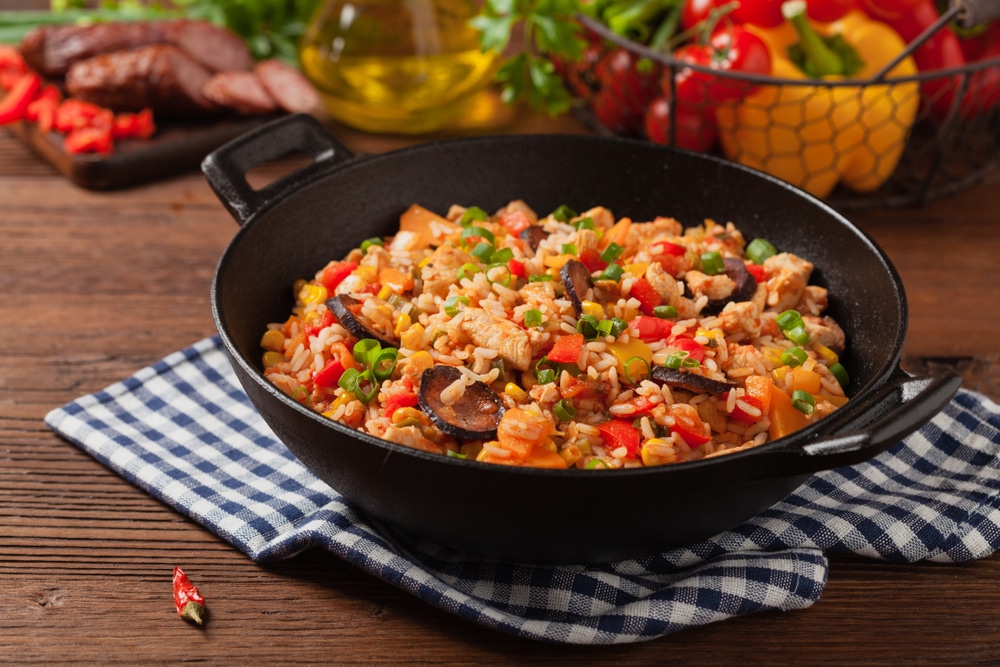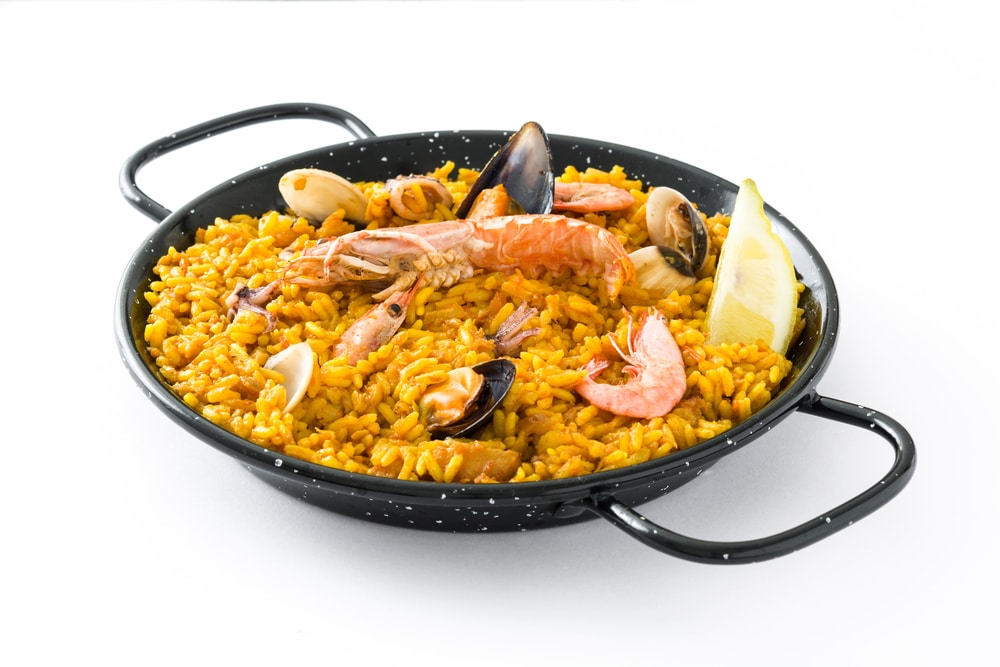What do you think of when you hear these two words – jambalaya and paella?
If you have ever eaten either dish before, you likely have strong feelings about which one is better. One of them might even be an integral part of your culture or heritage.
Jambalaya and paella are similar in many ways, but they differ in ingredients, cooking times, and preparation.
Let’s find out more about what makes these dishes different, so you can decide for yourself which one to try next.
Difference Between Jambalaya and Paella
The main difference between jambalaya and paella is the type of rice used. Jambalaya has evolved over the years thanks to a Creole and Cajun influence. Paella is more traditional. It finds its roots in Spain.
When making jambalaya, you cook rice in a mixture of broth and meat (usually chicken). This dish is traditionally served over rice.
Paella, on the other hand, uses short-grain white rice as its base. You can cook paella in a saffron-infused tomato sauce with seafood or meat and then serve it over pasta or bread.
Onions and bell peppers typically accompany both dishes, but they differ in usage and preparation. In jambalaya, you add vegetables to the dish at the end of cooking to retain their crunchiness and flavor.
In paella, some vegetables are cooked along with the rice to soften and cook into the sauce and add flavor to it.
While both dishes use tomatoes to add flavor to their sauces, jambalaya uses them in a tomato-based sauce. Paella uses tomatoes and saffron to give its sauce a rich yellow color.
Jambalaya vs Paella Comparison Table
| Differences | Jambalaya | Paella |
| Ingredients | Jambalaya is made with rice, chicken or seafood, sausage, and vegetables | Paella contains rice, seafood, chicken or meat (or vegetarian alternatives), and vegetables. The meats used in both dishes are typically pork or sausage. |
| Cooking Time | Jambalaya can be cooked in as little as 20 minutes on the stovetop. Still, traditionally it is left to simmer for several hours until all flavors have blended nicely. | Paella takes a little more time to make than jambalaya because it is cooked over a flame for about 45 minutes to an hour. |
| Sauce | Jambalaya is served with a thick sauce typically made from tomatoes and stock. | Paella has a thin sauce cooked in olive oil, garlic, and saffron until it forms a nice crust on the bottom of the pan. |
| Spice | Jambalaya is spicier than paella because it typically contains hot sausage or peppers instead of seafood. | Paella does not contain any spicy ingredients, but it does have an acidic flavor from the tomatoes used in the dish. |
| Rice | Jambalaya is made with long grain rice | Paella is typically made with short-grain rice because it is stickier than long-grain rice and thickens up the dish. |
| Garnish | Jambalaya is often served with a side of coleslaw or a salad to offset the dish’s spiciness. | Paella is traditionally garnished with parsley and lemon wedges. |
Can You Substitute Jambalaya for Paella?
You can substitute jambalaya for paella if you’d like, but it’s important to understand the flavor profiles won’t be the same. The key is not to alter the ingredients too much since they still rely on rice and broth.
You can also use your favorite kind of rice in place of the Spanish rice – arborio.
If you want to make your jambalaya taste more like traditional paella, try leaving out traditional Creole flavors like Andouille sausage. Replace the sausage with seafood for a more Mediterranean feel. You might also want to include saffron, if possible, though it can be highly expensive and often difficult to find.
Saffron is a difficult taste to replicate, and it’s one of the key components of paella. So, if you can’t find it or choose to leave it out, know that your substitution won’t be exactly the same.
What is Jambalaya?

Jambalaya is a kind of rice dish that originated in Louisiana. It is classified as both a Creole and Cajun dish, and its name loosely means “a mish-mash of rice.”
There are many theories as to how the dish was discovered. One of the most popular is that the “first” jambalaya was intended to be paella.
The theory suggests that Spanish settlers were attempting to make their traditional paella after arriving in New Orleans, but they had to substitute plentiful tomatoes for hard-to-find (and expensive) saffron.
The French culture in New Orleans eventually influenced the dish further, which is why jambalaya today is often made with things like Andouille sausage and other spices.
Its main ingredients are chicken and other meats and vegetables, but you can also make it with fish. It’s very similar to paella but uses French rice instead of arborio rice.
Jambalaya can be spicy if you add hot peppers, but you can eliminate them if you wish. You can also serve the dish with lots of vegetables and bread for people to mop up their sauce on the side.
How to Use Jambalaya
You’ll need a large stockpot or a large skillet to make a proper jambalaya. You can make the rice in the same pot or pan as you cook the meat and veggies, but if you want to serve it outside of your home, you’re going to need another vessel for serving it in as well.
To cook jambalaya, you will want to brown the meat, add all of the other ingredients to the pot, and bring it to a boil. The rice is added next, and then the liquid is brought back up to a boil again before being covered and simmered for 30 minutes or so.
After the rice has been added, you will want to bring the liquid back up to a boil again before covering it and simmering it for another 30 minutes or so. If desired, you can serve Jambalaya with coleslaw, cornbread, salad, or even French bread.
What is Paella?

Paella is a Spanish dish. It originated in Valencia, and it traces back to the 19th century.
The name paella comes from the unique round pan in which it’s cooked. Traditionally, the pan has two handles so it can easily be transferred from the outdoor oven to the table. It is to be served family-style, so everyone can dig in and enjoy.
Paella is similar to jambalaya in many ways. But, it uses different ingredients and is usually made with seafood in addition to things like chicken and sausage. If you want to make your paella vegetarian, you can replace the sausage with tempeh or tofu. You can also add more vegetables to make it a heartier meal.
Where paella stands out, however, is that it was most certainly the “first” dish between these two. You’ll see in a minute how paella had a large influence on the creation of jambalaya.
Without the Spanish impact on the U.S., jambalaya, as we know it today, likely wouldn’t exist. That’s the last thing a native Louisianian would ever want to hear!
How to Use Paella
Paella is traditionally cooked in clay-fired dishes called cazuelas, but if you’re making it at home, it can be prepared in a large, tall-sided skillet. The beauty of using a cazuela is that it allows for even cooking throughout the dish. It’s also non-porous, so none of the liquids will seep through while the dish is cooking.
If you plan on making a lot of paella, it might be a worthy investment to look into getting a cazuela of your own. There are many sizes and colors to choose from, and half the fun can be picking one out to fit your needs.
Traditional paellas are also made outdoors. They are often served in huge dishes piled high with golden rice, meats, and vegetables. They are an incredible “party” food and wonderful for summer get-togethers if you’re looking for something different than a traditional cookout.
Paella can be served with a variety of sides and/or toppings, including
- Salad
- Roasted red peppers
- Potatoes
- Fried plantain slices
- Bread
One of the best things about paella is that it’s easily customizable. While the main notable flavors are traditionally chicken broth and saffron, you can adjust them to fit your specific tastes.
However, try to leave at least a bit of saffron in the recipe. It gives the rice its traditional golden color and adds a sort of floral note to the dish. A little bit of saffron goes a long way. Again, if you plan on making paella frequently, it’s a worthwhile investment.
When it comes to toppings or sides, consider setting up a “paella bar,” so your guests can help themselves to a serving of the dish before adding whatever they want to the side. It’s less work for you and more fun for them!
Paella is perfect party food, but also a great family dish that can keep you and your loved ones satiated. Depending on the vegetables and meats used, it’s also a relatively healthy dish you can feel good about eating.
Related Food Comparison:






